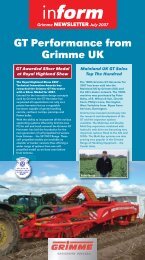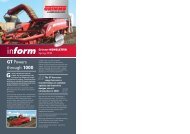inform - Grimme UK
inform - Grimme UK
inform - Grimme UK
- TAGS
- inform
- grimme
- grimmeuk.com
You also want an ePaper? Increase the reach of your titles
YUMPU automatically turns print PDFs into web optimized ePapers that Google loves.
Profitable<br />
Trailed or Self Propelled?<br />
harvesting relies on lifting potatoes at<br />
the right time and with a minimum amount of damage.<br />
These two growers believe there are real benefits to self<br />
propelled harvesters but not in all circumstances.<br />
Cost justify the decision.<br />
While self propelled harvesters can carry a hefty price tag, like all<br />
new investment if it can be realistically cost justified then it’s<br />
probably worth considering.<br />
Andrew Miller, based at Kellie Castle, near Anstruther in Fife<br />
grows over 500 acres of potatoes including 200 acres of salads.<br />
Harvesting can be a protracted operation.<br />
“We reckon to begin lifting at the start of July and keep going<br />
until October,” he says. “And as any grower worth his salt will tell<br />
you, harvesting potatoes is all about taking care not to bruise<br />
them – because nobody wants bruised potatoes.”<br />
Four years ago Mr Miller (pictured<br />
left) invested in his first selfpropelled<br />
harvester – a <strong>Grimme</strong> SF<br />
1700, which was specified with a<br />
track drive – and, earlier this year, a<br />
second machine arrived – an SF<br />
150-60.<br />
“So why run two self-propelled<br />
harvesters? First because basically<br />
we grow two crop types – salads<br />
and main crop with a smattering of<br />
other varieties to spread the work<br />
load,” he explains. “These include<br />
the varieties Charlotte and Nicola<br />
with Maris Piper and King Edward.”<br />
The 1700 is set with lifting and separation gear to cope with the<br />
more mature main crops - similar to the company’s GZ harvester -<br />
complete with a Multi-Sep unit plus a picking table and cart<br />
elevator.<br />
For the salads however, the SF 150-60 has been specified with<br />
smaller webs – the first main web delivers onto the de-viner web<br />
which takes the long pieces of haulm out of the back of the<br />
harvester and allows the potatoes to fall through onto the second<br />
main web where hedgehog-type separators, with their powered<br />
rollers complete the cleaning before the potatoes are transferred<br />
to a bunker.<br />
Control is the next reason, “It is a lot easier to harvest a crop<br />
properly without damage. Sitting on board the machine enables<br />
you to see and tweak settings and speeds to cater for different<br />
harvesting conditions.”<br />
He points out that the machine’s bank of cameras keeps him<br />
<strong>inform</strong>ed of how all the harvester’s components are performing<br />
and adds that on a trailed machine it is not always possible see<br />
how the crop reacts to changes to the settings.<br />
So, there are advantages for quality but how do the operating<br />
costs stack up?<br />
“As we are harvesting for about four months of the year, the<br />
argument that a tractor and trailed harvester enables a tractor to<br />
be used for other jobs doesn’t really hold water,” he explains. “The<br />
tractor is always in use on the harvester.”<br />
“There are also occasions when the pack house requires just a<br />
couple of loads harvesting. It‘s easy & cost effective to send out<br />
GRIMME <strong>UK</strong> LTD, Station Road, Swineshead,<br />
Boston , Lincolnshire PE20 3PS<br />
Tel: 01205 822300 • Fax: 01205 821196<br />
E-mail: info@grimme.co.uk • Website: www.grimme.com<br />
just one man with a tractor and trailer and the self-propelled<br />
harvester to complete the order. A trailed harvester gang would<br />
need probably four times this amount of labour.”<br />
For Mr Miller’s enterprise, the overall operating cost of self<br />
propelled is similar to trailed harvesters, but the main cost<br />
advantage is in being able to lift potatoes in a much more<br />
controlled way with fewer damaged tubers – and significant<br />
savings in labour.<br />
“Horses for Courses”, says Philip Benzie<br />
Philip Benzie grows and contract harvests more than 1000 acres<br />
of salad and main crop potatoes around Aberdeenshire. His fleet<br />
of potato harvesters comprises three trailed <strong>Grimme</strong> GZs and, for<br />
the first time this year, a self-propelled, two-row <strong>Grimme</strong> SF 150-<br />
60, which has had its intake web widened to cope with a 72in bed<br />
quad system.<br />
“We need this number of machines to cope with our contracting<br />
obligations,” he explains. “I am not so much concerned about<br />
output as being able to harvest potatoes without damaging them<br />
– that is the important part.”<br />
His decision to purchase a self-propelled potato harvester was<br />
based on the work it would be doing lifting his salad crop, yet he<br />
maintains he would not have purchased it if he was growing, for<br />
example, all main crop.<br />
The machine has a de-viner web and a hedgehog-type cleaning<br />
system, which is designed to be gentler on the potatoes and will<br />
hopefully keep the small salad potatoes in the machine. This is<br />
unlike the conventional machines fitted with haulm separators,<br />
which could pull the small potatoes out with the haulm.<br />
Like Mr Miller, Mr Benzie is convinced that having the operator so<br />
close to the machine and able to tweak adjustments so accurately<br />
results in another 0.25t/acre to be lifted, when compared with his<br />
trailed machines – an extra 25t for every 100 acres harvested.<br />
“Not only is this good news for me as a grower but also for the<br />
owners of the land we grow the crop on,” he says. “When they<br />
plant their next crop of cereals or what ever, they do not want to<br />
be troubled with an excessive number of keepers in the ground.”<br />
Mr Benzie also feels the self-propelled harvester scores over<br />
trailed machines when he is asked by the packer to lift between<br />
one and four lorry loads of salad potatoes per day. “We use a<br />
cushion box loading system in the field so it’s just a matter of<br />
sending up a couple of chaps and harvesting the required<br />
amount,” he explains. “It’s a real saving on labour costs.”<br />
The actual harvesting rate of the self-propelled when compared<br />
with the trailed machines is about the same, but as Mr Benzie<br />
observes, “The important part is lifting potatoes carefully – not<br />
just getting them out of the ground. The job’s not done until the<br />
potatoes are in the store.”<br />
Just how the operating costs compare between the self-propelled<br />
and the trailed machines is difficult to say just yet. “I feel there are<br />
savings – certainly in the labour required – but I think it is too<br />
early to be too specific. I’ll know more after we’ve completed the<br />
first year.”






